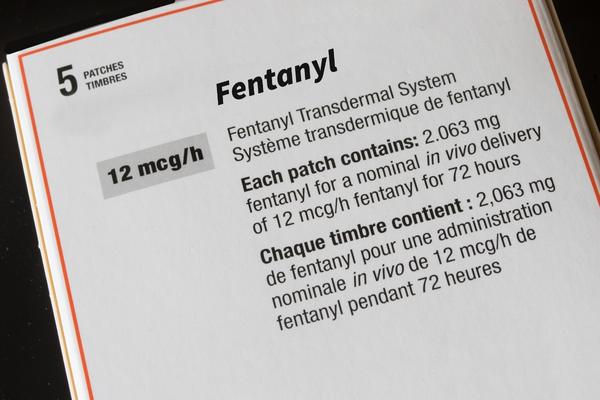The powerful opioid drug fentanyl is only prescribed for severe pain caused by serious medical conditions. Fentanyl is usually reserved for chronic pain, not acute pain. In addition to transdermal patches, there are other formulations of Fentanyl. It is available as solid oral preparations (lollipops), tablets, oral sprays, nasal sprays, and injectables. As an opioid medication, fentanyl can cause physical dependence and addiction within a few weeks of daily use. People become addicted to fentanyl because it causes intense euphoria. Fentanyl triggers the brain and central nervous system to release large amounts of dopamine and activate endorphins, which both lead to addiction in people who are susceptible to drug or alcohol issues.
Fentanyl is a powerful synthetic opioid that is similar to morphine but is 50 to 100 times more potent. (NIDA)
What is Illicit Fentanyl?
The opioid and Fentanyl addiction crises are mainly centered around illicit Fentanyl. Still, many people begin their addiction to Fentanyl by getting it from their doctor. The majority of illegal Fentanyl is manufactured in China, Mexico, Russia, and other places. The unlawful production of Fentanyl is done to make other opioids stronger to sell them on the street, such as heroin. To make a more potent illegal drug, just tiny amounts of Fentanyl need to be added. Compared to heroin and other non-synthetic opioids, Fentanyl is more addictive. Drug dealers can predict more profits when Fentanyl is used in street drugs because more people will become addicted to Fentanyl-laced drugs faster.
What Is a Fentanyl Patch?
Fentanyl transdermal patches are applied to the skin where the pain medication is then absorbed through the skin. They are usually re-applied -as new every 72 hours. In general, Fentanyl patches are used to relieve severe pain in people who depend on pain medications for an extended time and cannot use other types of pain medications. The brand name most often referenced for a Fentanyl patch is Duragesic. The patches’ strengths can be prescribed from 12mcg, 25, 50, 75, and 100-mcg doses. The 12-mcg patch is the most common since it can be modified versus more substantial amounts more efficiently. Most people prescribed Duragesic Fentanyl patches already have developed a tolerance to opioid pain killers, but not always.
Is Doctor Prescribed Fentanyl Different from Street Fentanyl?
The doctor prescribed Fentanyl will be regulated and safe, unlike illegally manufactured Fentanyl. Still, both types of Fentanyl are incredibly potent and can cause overdose and death with a minuscule amount. Today, most people abusing Fentanyl also abuse heroin and prescription pain killers. Anyone who is addicted to opioid-based drugs such as fentanyl patches or heroin will become violently ill if they do not keep a steady stream of the drug in their system at all times. Opioid tolerance is a physical dependency but not necessarily addiction. The difference is that addiction causes the person to want to use the drug regardless of the consequences. Physically dependent on opioids means the individual is physically addicted but not emotionally or mentally. The individual will need medical help to stop using Fentanyl or other opioids in either situation. A medically supervised detoxification that tapers them off the opioid is a medical requirement.
Who Can Overdose on a Fentanyl Patch?
Anyone can overdose on a Fentanyl patch, but people who have no tolerance for opioids are especially at risk. Still, people who use Fentanyl regularly to get high also run the risk of accidental overdose. Many addicts combine Fentanyl with other legally prescribed medications such as benzodiazepines, prescription pain meds, sleep medications, street drugs like heroin, or more Fentanyl. Not many people realize that fentanyl is 50 times more potent than heroin and 100 times more potent than morphine. It is a central nervous system depressant, and if someone consumes other depressant drugs, even alcohol, they can overdose and die. The signs of fentanyl patch overdose resemble other fentanyl overdose symptoms and include:
- Nausea and vomiting
- Cold and clammy skin
- Low blood pressure
- Drowsiness
- Dizziness
- Blue-colored lips and fingernails
- Slowed or stopped breathing
What Do The Experts Say About Fentanyl Patches and Addiction?
The National Institutes on Drug Abuse explain how addiction to Fentanyl happens and how physical dependency also occurs.
Fentanyl is addictive because of its potency. A person taking prescription Fentanyl as instructed by a doctor can experience dependence, characterized by withdrawal symptoms when the drug is stopped. A person can be dependent on a substance without being addicted, but dependence can sometimes lead to addiction. (NIDA)
If you or a loved one are addicted to fentanyl, we are here to help with our fentanyl addiction treatment programs that focus on recovery from prescription and street opioids. We have many years of experience in effectively treating fentanyl abuse and dependency. Contact us around the clock to learn more about how we can assist you or a loved one on the journey to lasting sobriety.



